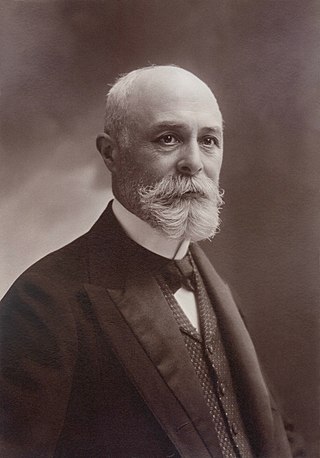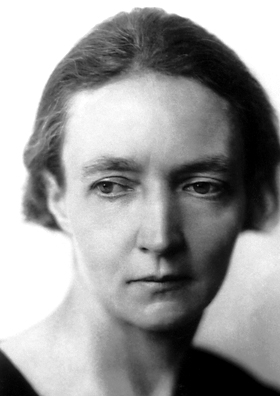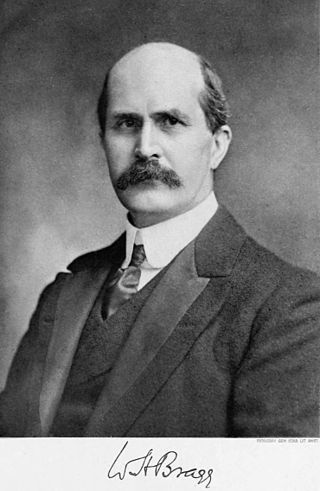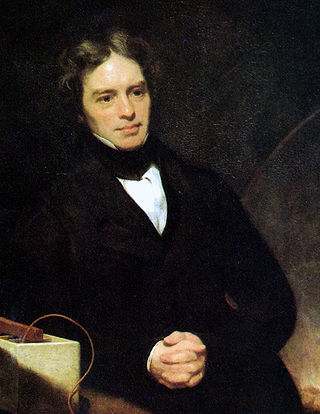Related Research Articles

John William Strutt, 3rd Baron Rayleigh, was an English physicist and mathematician. He spent all of his academic career at the University of Cambridge. Among many honours, he received the Nobel Prize in Physics in 1904 "for his investigations of the densities of the most important gases and for his discovery of argon in connection with these studies". He served as president of the Royal Society from 1905 to 1908 and as chancellor of the University of Cambridge from 1908 to 1919.

Pierre Curie was a French physicist, chemist and a pioneer in crystallography, magnetism, piezoelectricity and radioactivity. He shared the 1903 Nobel Prize in Physics with his wife, Marie Curie, and Henri Becquerel "in recognition of the extraordinary services they have rendered by their joint researches on the radiation phenomena discovered by Professor Henri Becquerel". With their win, the Curies became the first married couple to win the Nobel Prize, launching the Curie family legacy of five Nobel Prizes.

Antoine Henri Becquerel was a French physicist who shared the 1903 Nobel Prize in Physics with Pierre and Marie Curie for his discovery of radioactivity. The SI unit of radioactivity, the becquerel (Bq), is named after him.

Wilhelm Conrad Röntgen was a German physicist, who, on 8 November 1895, produced and detected electromagnetic radiation in a wavelength range known as X-rays or Röntgen rays, an achievement that earned him the inaugural Nobel Prize in Physics in 1901. In honour of Röntgen's accomplishments, in 2004, the International Union of Pure and Applied Chemistry (IUPAC) named element 111, roentgenium, a radioactive element with multiple unstable isotopes, after him. The non-SI unit of radiation exposure, the roentgen (R), is also named after him.

Irène Joliot-Curie was a French chemist and physicist who received the 1935 Nobel Prize in Chemistry with her husband, Frédéric Joliot-Curie, for their discovery of induced radioactivity. They were the second married couple, after her parents, to win the Nobel Prize, adding to the Curie family legacy of five Nobel Prizes. This made the Curies the family with the most Nobel laureates to date.

Frederick Augustus Porter Barnard was an American academic and educator who served as the 10th President of Columbia University. Born in Sheffield, Massachusetts, he graduated from Yale University in 1828 and served in a succession of academic appointments, including as Chancellor of the University of Mississippi from 1856 to 1861. He assumed office as President of Columbia University in 1864, where he presided over a series of improvements to the university until his death in 1889. He was also known as an author of academic texts.

Sir William Henry Bragg was an English physicist, chemist, mathematician, and active sportsman who uniquely shared a Nobel Prize with his son Lawrence Bragg – the 1915 Nobel Prize in Physics: "for their services in the analysis of crystal structure by means of X-rays". The mineral Braggite is named after him and his son. He was knighted in 1920.
The year 1871 in science and technology involved some significant events, listed below.

Sir William Huggins was a British astronomer best known for his pioneering work in astronomical spectroscopy together with his wife, Margaret.
Experimental physics is the category of disciplines and sub-disciplines in the field of physics that are concerned with the observation of physical phenomena and experiments. Methods vary from discipline to discipline, from simple experiments and observations, such as Galileo's experiments, to more complicated ones, such as the Large Hadron Collider.
Sir Richard Tetley Glazebrook was an English physicist.

Jacqueline K. Barton, is an American chemist. She worked as a professor of chemistry at Hunter College (1980–82), and at Columbia University (1983–89) before joining the California Institute of Technology. In 1997 she became the Arthur and Marian Hanisch Memorial Professor of Chemistry and from 2009 to 2019, the Norman Davidson Leadership Chair of the Division of Chemistry and Chemical Engineering at Caltech. She currently is the John G. Kirkwood and Arthur A. Noyes Professor of Chemistry, Emerita.

Robert John Strutt, 4th Baron Rayleigh was a British peer and physicist. He discovered "active nitrogen" and was the first to distinguish the glow of the night sky.
The Matteucci Medal is an Italian award for physicists, named after Carlo Matteucci from Forlì. It was established to award physicists for their fundamental contributions. Under an Italian Royal Decree dated July 10, 1870, the Italian Society of Sciences was authorized to receive a donation from Carlo Matteucci for the establishment of the Prize.

John Cromwell Mather is an American astrophysicist, cosmologist and Nobel Prize in Physics laureate for his work on the Cosmic Background Explorer Satellite (COBE) with George Smoot.

The Faraday Lectureship Prize, previously known simply as the Faraday Lectureship, is awarded once every two years (approximately) by the Royal Society of Chemistry for "exceptional contributions to physical or theoretical chemistry". Named after Michael Faraday, the first Faraday Lecture was given in 1869, two years after Faraday's death, by Jean-Baptiste Dumas. As of 2009, the prize was worth £5000, with the recipient also receiving a medal and a certificate. As the name suggests, the recipient also gives a public lecture describing his or her work.
The Janssen Medal is an astrophysics award presented by the French Academy of Sciences to those who have made advances in this area of science.

William J. (Bill) Borucki is a space scientist who worked at the NASA Ames Research Center. Upon joining NASA in 1962, Borucki joined the group conducting research on the heat shield for Apollo program spacecraft. He later turned his attention to the optical efficiency of lightning strikes in the atmospheres of planets, investigating the propensity that these lightning strikes could create molecules that would later become the precursors for life. Subsequently, Borucki's attention turned to extrasolar planets and their detection, particularly through the transit method. In light of this work, Borucki was named the principal investigator for NASA's Kepler space telescope mission, launched on March 7, 2009 and dedicated to a transit-based search for habitable planets. In 2013, Borucki was awarded the United States National Academy of Sciences's Henry Draper Medal for his work with Kepler. In 2015 he received the Shaw Prize in Astronomy.
The Institute of Physics awards numerous prizes to acknowledge contributions to physics research, education and applications. It also offers smaller specific subject-group prizes, such as for PhD thesis submissions.
References
- ↑ "Report on the F. A. P. Barnard Medal". Annual Report - National Academy of Sciences: 67. 1908. Retrieved 28 October 2014.
- ↑ WikiCU (Columbia University). Barnard Medal for Meritorious Service to Science
- ↑ "Award of Barnard Medal". Columbia Daily Spectator. Vol. XLIII, no. 57. 23 May 1900. Retrieved 28 October 2014.
- ↑ "Award of the Barnard Medal". Science. New Series. 21 (547): 965–966. June 23, 1905. doi:10.1126/science.21.547.965-a. JSTOR 1629898. PMID 17818018. S2CID 37381218.
- ↑ "Butler Scientists' Host: Brilliant Gathering at Athenaeum as Rutherford Receives Columbia Medal". The New York Times. July 1, 1910. Retrieved 28 October 2014.
- ↑ "Barnard Medal Goes to Research Scientist". Columbia Daily Spectator. Vol. XLIX, no. 142. 27 April 1925. Retrieved 28 October 2014.
- ↑ "Barnard Medal Award". Report of the National Academy of Sciences: 13. 1935. Retrieved 28 October 2014.
- ↑ Annual Report of the National Academy of Sciences (1960 ed.). Washington, D.C.: National Academy of Sciences. 1957. p. 203.
- ↑ Editor's Desk (22 September 1889). "A Barnard Medal". New York Times. New York Times. Retrieved 22 May 2014.
{{cite news}}:|last1=has generic name (help) - ↑ Wilk, Jocelyn K. (Associate University Archivist) (11 June 2014). Barnard Medal for Meritorious Service to Science (2014 ed.). New York, New York: Columbia University Rare Book & Manuscript Library.
- ↑ "Commencement - 1910". Columbia University Quarterly. 12 (4): 382. September 1910.